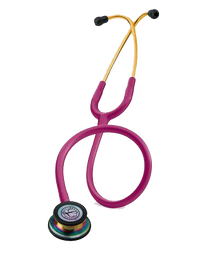Choosing the right stethoscope

Choosing the right stethoscope
A stethoscope draped around the neck has long been the badge of the medical professional, and it is worn with pride by physicians, nurses and respiratory therapists.
Like any piece of medical equipment, there are a number of available choices, and the design and care of the stethoscope may have a substantial impact on its performance. Sound quality with any stethoscope can be substantially degraded by failure to maintain the integrity of the rubber fittings, and prolonged contact of the tubing with the skin when worn around the neck can lead to hardening of the tubing and decreased performance. In any case, the stethoscope must be kept clean because it is increasingly recognized as a vector of nosocomial infection.1
The stethoscope consists of two earpieces angled at the same angle as the ear canal, rubber tubing, and a head with either a diaphragm (plastic disc) or a bell (hollow cup). The diaphragm accentuates high-frequency sounds; the bell transmits low-frequency sounds. Dual-headed stethoscopes have both a diaphragm and a bell. Some stethoscopes have only a diaphragm (no bell); some stethoscopes have a pressure-sensitive tunable head that functions as both a diaphragm and bell depending on the applied pressure.
Although the choice of style (e.g., Sprague-Rappaport type with dual tubing, Littmann type with a single tube, or a Cardiology type stethoscope) depends on personal preference, quality is important. A cardiology stethoscope can be distinguished by the different shaped head, having only a diaphragm but it is also available in dual head. The key difference is in the tubing. Dual-lumen tubing combines two sound paths in one tube, eliminating the rubbing noise of traditional double tubes. This provides the clinician with superior sound profile especially for high-frequency sounds being assessed by cardiology specialists. The earpieces should fit the ear canals snugly and comfortably; the goal is for the sound to be transmitted from the patient to the eardrum through an unbroken system. Most high-quality stethoscopes come with several different sizes and shapes of ear tips, which enables the user to select the best-fitting and most comfortable tips.
The classic stethoscope has two different heads to receive sound, the bell and the diaphragm. The bell is used to detect low-frequency sounds and the diaphragm to detect high-frequency sounds. The traditional explanation that the bell selectively transmits low-frequency sounds and the diaphragm selectively filters out low-frequency sounds is probably incorrect. Actually, the bell transmits all frequencies well, but in some patients with high-frequency murmurs (e.g., aortic regurgitation), any additional low-frequency sound masks the high-frequency sound and makes the murmur difficult to detect.3 The diaphragm does not selectively filter out low-frequency sounds but instead attenuates all frequencies equally, thus dropping the barely audible low-frequency ones below the threshold of human hearing.
Many studies have examined the acoustics of stethoscopes, but the clinical relevance of this research has never been formally tested.2 The optimal internal bore of a stethoscope is somewhere between one-eighth and three-sixteenths of an inch because smaller bores diminish transmission of the higher-frequency sounds.2,3,5 Compared with shorter lengths of stethoscope tubing, longer tubes also impair the conduction of high-frequency sounds but can enhance low-frequency sounds which is what is most often auscultated.5
Most modern stethoscopes, however, transmit sound equally well, the differences among various models for single frequencies being very small.3 The most important source of poor acoustic performance is an air leak, which typically results from poorly fitting earpieces. Even a tiny air leak with a diameter of only 0.015 inch will diminish transmission of sound by as much as 20 dB, particularly for those sounds of less than 100 Hz.
The elitecare¨ Sprague Stethoscope features five chest piece fittings (two diaphragms and three bells for infant, paediatric and adult). It may be the huge selection of colours or it may be the price, but this model outsells all other stethoscopes worldwide.
So here's the bad and the good news...
The bad news can be the cost of a stethoscope: 3MªLittmann¨ can be very expensive and will cost around $150 for Classic III with Cardiology IV close to $300. This is because of the specialised design, the high-quality materials used to improve sensitivity and sound quality and the brand name. The good news is that it is premium quality.
The good is also the elitecare stethoscopes, and are sold at around $90 making it half the price of other brands. They also come with a 3 year warranty. Regardless whether you are a cardiologist, physician, nurse or a student, elitecare & Riverstone Medical has a model to suit your clinical requirements. Best of all the Riverstone CAS III is affordable for all.
Source:
1. Contamination Level of Stethoscopes Used By Physicians and Physician Assistants Robert L. Wilkins, PhD, RRT, FAARC; Ruben D. Restrepo, MD, RRT, University of Texas Health Science Center at San Antonio, Texas Kenrick C. Bourne, DrPH, PA-C, MT(ASCP); Noha Daher, DrPH, Loma Linda University, California, The Journal of Physician Assistant Education | 2007 Vol 18 No 2 pp.41-43
2. Richard JD, Gables C: Frequency spectra of some normal heart sounds. Am Heart J 1957;53:183Ð192
3. Abella M, Formolo J, Penney DG: Comparison of the acoustic properties of six popular stethoscopes. J Acoust Soc Am1992;91(4, pt. 2):2224Ð2228
4. Stethoscopes: Real-ear measurements and digital frequency transposition
Dolan, Thomas G.; Oliver, Sara R.; Maurer, James F.
The Hearing Journal: January 2001 - Volume 54 - Issue 1 - p 36Ð44
5. Frequency Response Measurements on Commercially Available Stethoscopes Pekka Korhonen, Sakari Lukkarinen, Raimo Sepponen, Juha Backman, Heikki RuotoistenmŠki Kimmo Rajala Applied Electronics Laboratory, Helsinki University of Technology Otakaari 5 A, FIN-02150 Espoo, Finland
A stethoscope draped around the neck has long been the badge of the medical professional, and it is worn with pride by physicians, nurses and respiratory therapists. Like any piece of medical equipment, there are a number of available choices, and the design and care of the stethoscope may have a substantial impact on its




